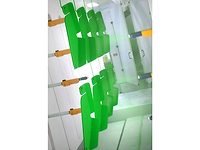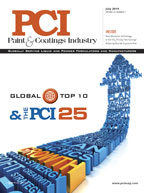How Full Are Your Fill Lines?

TABLE 1 | World’s 10 largest coatings producers.
Coatings producers that improve productivity faster than their competitors will prosper as the economy revives, enabling them to have full fill lines. Overall coatings productivity growth over the last 24 years has been underwhelming. Best defined as units of output compared to units of asset inputs – labor, capital, managerial skills, and/or better technology – overall productivity has actually declined in this period, according to figures compiled by the Bureau of Labor Statistics (BLS) of the Department of Commerce (Table 1).
Overall productivity actually declined an average of 1.0% annually from 1987 to 2011, the most recent year for which statistics are available. According to the BLS, productivity plummeted 5.5% annually during the 2007-2009 period and then skyrocketed 5.2% annually during the next two years. This record reflects first the disastrous business conditions affecting coatings users during the recession. Since typical coating producers are highly automated, they have fewer opportunities to reduce employment to match declining sales than do less-automated industries. But as coating consumption increased as user industries recovered, coatings producers could operate their plants more fully. With relatively few workers, running fill lines longer and faster produced their employees’ jump in productivity.
Good News, Bad News
Before painting too rosy a picture of the future, let's look at two snapshots of today’s reality. First ,the good news. Overall demand and sales are up. The use of decorative coatings in the United States is affected by overall housing activity and new construction, which are reviving. Architectural coatings generate about 40% of the industry's revenue. The demand for product finishes (for furniture, cars and other consumer items) is also up. This segment accounts for about 25% of the industry's sales. Similarly, the consumption of industrial coatings is a result of higher demand for durables like cars, packaging for all types of household durables, and construction and agricultural equipment. They take about 20% of the industry's output.
Now the bad news. Although the demand for coatings of all types is reviving, producers face the challenge of new environmental restrictions, as they try to reduce the VOC content of their solvent-based coatings. The use of waterborne and powder coatings and other high-solids formulations will grow. Retrofitting equipment to comply with new restrictions and formulating coatings to meet new "green" consumer demands will all be expensive.
The 50 largest coatings producers account for about 80% of the industry's revenues, and have the resources to finance these new requirements. But there are a total of about 1,100 American producers of coatings products. Most are medium size, from 20 to 250 employees, having average annual sales of about $25 million and limited resources for investment. Their profitability depends upon technical expertise and efficient production. Many of these smaller coatings companies make private brand labels for decorative uses, specialty coatings for industrial use, water-resistant applications, or corrosion prevention, etc.
What the News Means
As industry sales (which total about $22 billion) recover along with the economy, higher overall demand for coatings means even inefficient producers are doing better. And because of this first picture, a second one comes into focus. That is, since most coatings executives are busy dealing with new orders and putting out fires, they have little time to consider their long-term needs of boosting their own overall productivity and enhancing their own market competitiveness. As Ford Motor’s Chairman Bill Ford recently said, “I’ve learned you have to go faster and bet bigger when you are doing well.”1
Industry executives looking beyond tomorrow know there are four ways to “bet bigger”: boost worker productivity, increase supervisory efficiency, improve managerial effectiveness, and/or invest in new technology. The first three can be mastered with a modest investment, a relatively small expenditure of time, and a willingness to challenge the status quo before it becomes the status woe. The latter – new investment – takes capital, which means calling on commercial loan officers at local banks. There, visitors are still being met with frosty frowns because credit is so strictly monitored now. But taken together, all four ways to bet bigger will result in lower per-unit costs and the ability to compete successfully now and tomorrow as the economy continues its lurching climb.
Let's look at all four, by starting with the simplest and fastest to accomplish, and moving on to the complex.
Employees and Employee Productivity
The simplest way to boost productivity at the worker level is by creating incentive systems to motivate them to work smarter and, if needed, harder to cut waste, make more efficient use of materials, and increase output.2
Most workers want to do a good job, be productive and be rewarded for their efforts. When a reward system like gainsharing is implemented by an expert with experience in the coatings industry, history shows that productivity will improve from 17 to 22 percent.3
But how do you measure productivity? While many executives sit up late thinking of ways to improve productivity, few in my experience do an adequate job of measuring it. Most settle for a simple figure – sales dollars per man hour worked, even though they make a variety of coatings in everything from half-pint containers to 55-gallon drums. Having dealt with many coating industry executives in my career, few of them, especially those managing the smaller, specialty producers (again, 70% of the industry's sales come from smaller producers), devote enough time in devising understandable productivity measures that can be communicated to employees, or to developing effective incentives that motivate workers to strive for the continuous productivity improvement needed to please today’s price-conscious customers.
A simple measure of productivity is pounds or gallons of product produced per man hour worked. That can be measured in terms of direct labor, overall plant labor, or all labor, plant as well as technical and office workers, and is easily understood by all.
Obviously, pounds or gallons per hour worked is a crude but understandable measure. Corrections can be made for the types of coatings produced, length of production runs and size of containers. But once the corrections are made, coating industry executives have a simple, effective measure that is easily communicated and understood.
The latter is important because coating producers wishing to improve employee productivity must provide understandable benchmarks for employees to shoot for as well as rewards for exceeding them. Surveys tell us employees tire of celebration lunches quite quickly.4
Moreover, astute coating industrymanagers look beyond direct labor productivity. They focus on overall productivity by including other workforce segments in their calculations. By adding additional classes of employees – supervision, quality and technical support, and/or office workers – these executivescan quickly determine their effect on overall productivity and bottom-line profitability as well. Whether to hire another maintenance man to keep the fill lines running or an additional technical staffer then becomes an easier decision.
Supervisory Efficiency
There are two reasons why few coatings companies measure supervisory efficiency or the effectiveness of their managers, or make many efforts to improve either. First, it is usually difficult to measure results and second, inertia. Blaming "lazy" workers for mediocre productivity is easier than upsetting long-term supervisors and mid-managers who are set in their ways. For most companies in the industry,especially the smaller ones, "good enough is often good enough," if a modest profit is made.5 Those trying to upgrade their supervisors often buy inexpensive training programs, usually from the internet. While these generalized courses might help new, bewildered "newbie" supervisors, they give the more experienced ones inured to the inevitable little reason for change. Moreover, most canned training aims at helping supervisors manage the behavior of their subordinates, rather than showing them how to manage the work of their subordinates. Teaching supervisors how to deal with sassy employees is fine, but does little for productivity. Real-time scheduling to coordinate production from blending through the fill lines to shipping does. After all, isn't improving departmental efficiency why supervisors are paid?
These deficiencies can be rectified by retaining a knowledgeable trainer who takes the time to understand existing supervisory practices and attitudes before making recommendations to improve them. This understanding can be accomplished by interviewing supervisors to determine how they perceive their work environment and then talking with mid-managers to obtain an overall view of how operations actually run. Only then can realistic plans be made about the training content, how to set proper goals to measure its effectiveness, how to conduct the sessions with enough pizazz to keep even the most jaded of supervisors awake, and finally, how to measure the results over time and communicate them back to the supervisors in question.
Management Effectiveness
Improving managerial skills by development efforts is a fraught subject. The critical skill most managers need is making better use of their time – their scarcest resource. Managerial effectiveness can be improved by helping individual managers define their key objectives and then teaching them how to focus their time on those, leaving the hum-drum to subordinates.
Again, the first step is for a knowledgeable expert to interview a coating company’s executives to discover how they see the problems, and then to check with mid-managers to validate their concerns. Effective training can then be designed based on reality. This is more effective than merely inflicting upon unsuspecting manager’s lists of KPIs (Key Performance Indicators) and then expecting them somehow to shine.
Effective training then begins by helping individual managers set key goals, obviously, with input from upstairs. After managers are asked to demonstrate just how they actually spend their time, they can be shown objectively where they are spinning their wheels and when they are devoting their time to the most worthwhile activities that contribute the most to their key goals.
Managers can be shown how much each of their activities contributes to all of their goals. Then, managers can be shown how all their activities contribute to each of their specific goals. Once internalized and re-enforced, managers will use their time to their maximum advantage – as well as to their company’s.
Capital Investment
Finally, an important way to improve overall productivity is to substitute capital for labor, a trend that started the industrial revolution centuries ago. Again, in my experience, few coating executives – especially those in smaller operations – have ever asked themselves what return on capital they want before investing in new equipment or "better" technology.
Let's say a new color matching system for the lab will improve quality and reduce customer returns. If the unit costs $25,000 and the owner wants a 20% initial return on his investment, then he needs to ask whether the $25,000 he invests will result in $5,000 in annual savings, i.e., perhaps by reducing returns or improving fill-line uptime. Obviously, depreciation schedules and other tax issues confuse things, but that’s what keeps accountants and tax attorneys out of trouble. To complicate matters, the returns on investment for new fill-line equipment to speed production or implementing an ERP system to improve scheduling are not easy to estimate. But efforts should be made.
Although the industry's giants – AkzoNobel, PPG Industries, Sherwin-Williams, Axalta (formerly DuPont), etc. – have scores of staffers who generate reams of printouts covering all scenarios. Smaller producers don't have this luxury.
In real life, the results of new investment for smaller producers are more guestimates than anything else. And they are often over-estimated by gung-ho managers for two reasons: first, because many need a stronger shot of reality in their morning coffee, and second, because little effort is made to include employees in the decisions. As a result, workers see proposed changes in equipment and process as simple head-chopping exercises and find subtle ways to torpedo them in real life.
All Together Now
One can easily sympathize with the executives of small- to medium-size paint manufacturers and coating producers who constantly juggle the day-to-day realities of maintenance breakdowns, managerial issues, and customer demands for lower prices and last-minute schedule changes. Some of these problems are the eternal nature of the coatings industry. Customers might not always be right, but they are customers. There are too many competitors willing to put up with their transgressions.
Other problems are self-inflicted. It is very easy to sympathize with harried executives so immersed with the concrete day-to-day problems of juggling customer demands that they delay challenging internal inertia within their own companies. This long-term threat to their companies’ future can be overcome by dealing with subordinates openly and honestly: by rewarding outstanding performers and sanctioning mediocre ones at all levels; by showing managers how to function with high effectiveness; by providing supervisors with the training needed to run their departments with measured efficiency; and by implementing incentive systems like gainsharing for better productivity at the lower levels. Because if executives like you don’t do it, your competitors will be the ones whose fill lines are full…and fast.
For more information, contact Dr. Woodruff Imberman, President, Imberman and DeForest, Inc. at 847/733-0071, or info@imbdef.com.
1Ramsey, M. Fuel Goal Tests Ford’s Mettle, Wall Street Journal, 13 Jan, 2014, pg. B1.
2Imberman, W. Gild Your Bottom Line, Paint & Coating Industry, March, 2007; and Imberman, W. How Long Will The Gilding Glitter? Paint & Coating Industry, April, 2008.
3Productivity Sharing Programs: Can They Contribute to Productivity Improvement? U.S. General Accounting Office, 1991.
4Trends in ‘Engaging’ Employees to Boost Productivity, Area Development, Nov. 2012.
5 Where Do You Stand? Area Development, December, 2002.
Looking for a reprint of this article?
From high-res PDFs to custom plaques, order your copy today!







